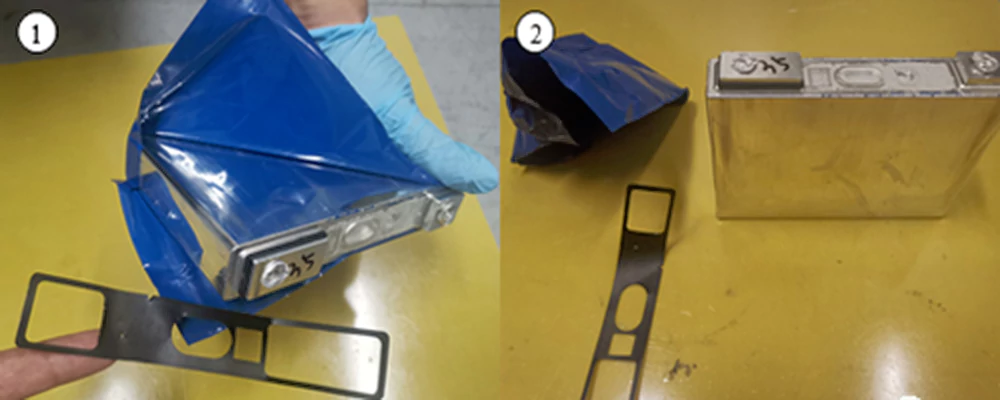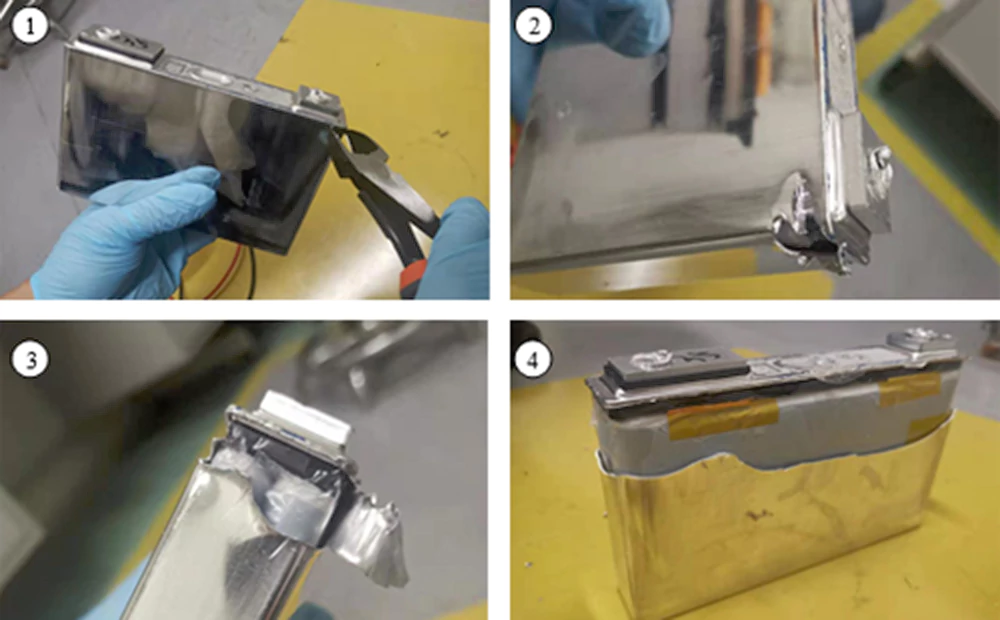Among the three shell types of cylindrical cell, pouch cell, and prismatic cell, prismatic cell has the highest versatility and market share. But if you want to dismantle the battery to study the internal process design, it is required to ensure safety without short circuiting and without affecting the internal structure. How should you disassemble it?
1.Purpose
Guide the disassembly of single prismatic cell samples to ensure safe, accurate and effective disassembly specifications.
2. Disassembly methods and requirements
2.1 Dismantling the environment.
Dismantling of battery cells should be carried out under the following conditions:
Temperature: 25℃±5℃
Relative humidity: ≤30%RH
Atmospheric pressure: 86KPa~106Kpa
2.2 Dismantling site requirements
a. The dismantling site should have safety precautions, such as fire-fighting facilities, alarm facilities, emergency facilities, etc.
b. The dismantling site should be hardened and leak-proof, with environmental protection facilities.
c. The dismantling site should be kept dry.
2.3 Disassemble tools
a. A pair of diagonal pliers
b. A pair of ceramic scissors
c. A ceramic knife
d. A pair of wire cutters
e. One ceramic tweezers
f. A multimeter

2.4 Security requirements
a. Before disassembling the battery, personnel should wear anti-static clothing, goggles, masks, gloves, and finger cots, and should not wear metal objects such as watches, rings, etc.
b. Dismantling personnel should have corresponded professional knowledge and undergo internal training and assessment.
c. During the disassembly process, for the sake of convenience and safety, it is strictly prohibited to work alone.
2.5 Preprocessing
a. Collect information such as battery model, manufacturer, voltage, size, and quality to be disassembled.
b. Turn on the laboratory humidity control equipment 2 hours before disassembling the battery. The relative humidity must be controlled below 2% before the experiment can be carried out.
2.6 Disassemble the cells
a. Use a ceramic knife or other sharp tool to remove the battery plastic casing.

b. After the plastic shell is removed, use diagonal pliers to tear a small opening in the neck area of the aluminum shell below the positive terminal of the battery (be careful to keep it as close to the upper cover as possible to avoid accidentally damaging the jelly roll). Then slowly tear off the neck aluminum shell along the cover.

c. Use ceramic scissors to cut off the battery tabs connecting the cover sheet to the jelly roll.

d. Use diagonal pliers to slowly tear off the remaining aluminum shell and take out the jelly roll inside.

e. Tear off the protective film outside the jelly roll by hands, separate the two parallel jelly roll and place them one after another, and then use ceramic tweezers to tear off the high-temperature tape outside the separator.

f. Use ceramic tweezers to peel off the termination tape outside the jelly roll. Hold the jelly roll firmly with the left hand, find the anode, pinch the cathode and anode of the jelly roll together with the right hand, and unwind slowly (the jelly roll must be in a tight state to prevent the cathode and anode from being misaligned). Considering that the prismatic lithium-ion battery cells is relatively long, you can use ceramic scissors to cut off the anode electrode when unwinding it to the appropriate position and then continue unwinding (pay special attention to cutting off only the anode electrode). Observe and record the shape of the cathode and anode electrode, separators, and electrolytes inside the cells.

(1) The anode electrode appears golden yellow as a whole (fully charged state), and observe surface defects. For example, whether there are wrinkles (which may affect the adhesion of the electrode. The overall wrinkles of the electrode may be caused by improper stress control during winding. Insufficient drying of the electrode coating, local wrinkles may be caused after rolling, etc.). Black spots (may be caused by transition metal elements such as Ni deposition, impurities, etc. You can use EDS to detect element distribution and content for comparison, SEM to measure size and other methods for analysis). Insufficient lithium insertion (for example, the edge of the anode electrode is brown striped, which may be related to overcharging or electrolyte infiltration). Local wrinkles at the bends of the electrode or insufficient lithium insertion (may be related to winding control, the electrode expands when fully charged and deforms at the bends) and lithium precipitation, etc.
(2) Observe the overall color of the cathode electrode to see if there are any abnormalities. For example, if the hot-pressing temperature is high or the time is long, the powder on the separator coating may fall off and adhere to the surface of the cathode electrode. Abnormal points observed at the anode electrode can be observed or detected at the corresponding position of the cathode electrode.
(3) Observe whether there are any abnormalities such as damage or deformation on the surface of the separator. The direction of the coating can be observed from the difference in reflection on the surface of the separator.
g. Observe and record the status. You need to throw the anode electrode into a fire bucket with water. After the anode electrode reacts with the water and burns out, throw the cathode electrode and other battery-related parts into the fire bucket. Continue to observe for two days and do waste disposal after two days.
Notice:
1. The environment for dismantling prismatic cells must be low-humidity (dew point ≤ -10°C). If there are no special requirements, it is best to discharge the battery cells.
2. Large-capacity battery cells usually use stacking process. When taking out the cathode and anode electrodes one by one, be sure to avoid contact and short circuit.
3. The aluminum shell is very thick and sharp, so be careful not to get scratched or punctured during the disassembly process.
4. In case of short circuit and fire during the process, personal safety comes first. Throw the cells into the prepared fire bucket.